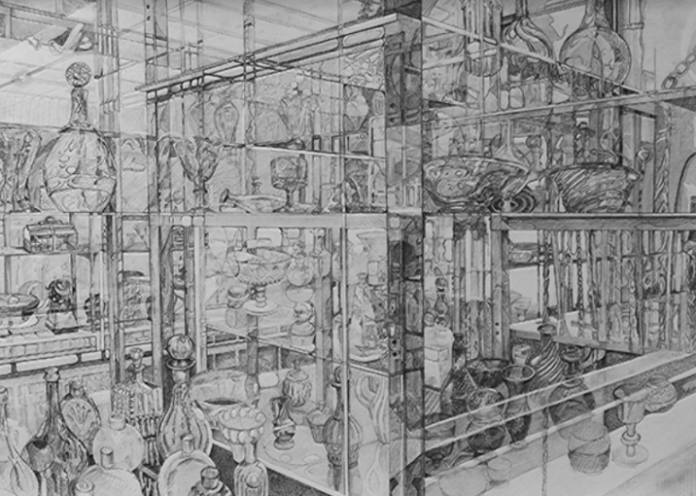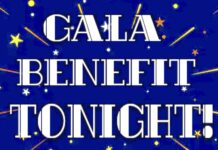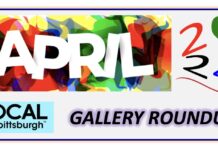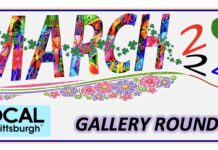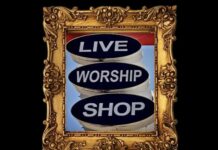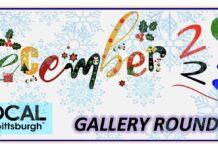Walk into 707 and 709 Galleries this week, and you will enter a dual exhibition – one a series of shockingly colorful paintings and the other of almost disorientingly intricate drawings, all meant to make you more aware of the environment around you, both artificial, personal and political.
Visual artist and Carnegie Mellon professor Kristen Letts Kovak is the artist behind the show On Looking and White Noise. Expanding on her long term exploration of perception, she created paintings and drawings of museum spaces and objects, specifically looking at the individual’s relationship with the space.
The shimmering paintings in 707’s On Looking capture moments from her travels to museums across the United States and around the world, exposing how light distorts our perception and even our memory of the objects and the location. By using bold colors and altering what would usually be painted in a hyper-realistic fashion, she highlights and exposes the artifice we often forget that is present in familiar environments.
In The Daughters, she paints a room filled with sculpture from Pittsburgh’s own Carnegie Museum of Art, but in it she repeats works from different angles and even includes life-sized figures pulled from a painting not in the museum – John Singer Sargent’s The Daughters of Edward Darley Boit.
“As I kept looking,” Kovak explained, “I thought of this painting…I started to mentally superimpose these two images on top of each other, stamping a new history. Those are the associations we make when we see something.”
But the art in Kovak’s exhibit is not only about our experience of a place, rather it is ultimately about how we perceive and treat these objects. In The Wonder of Human Ingenuity, Kovak paints a museum room that recreates the curiosity cabinets or wunderkammer. By filling it with primarily natural objects – fossils, stuffed birds, skulls – she exposes the human obsession with ownership of the exotic.
“In a museum environment, there is always super intense lighting. There are always reflections and shadows that are intensified. It transforms an everyday object and turns it into this epic artifact you get to experience outside of its original function… You’re just supposed to look at it and revel that this thing exists and that you get to visually own it for a moment.”
Indeed, looking around the room, observers will notice that all the functional objects depicted have a foreign quality, whether it is the Chinese dishes and lion statues that were once the obsession of Orientalist collectors, the twisted shapes of Greek figures or the distorted coloration of European 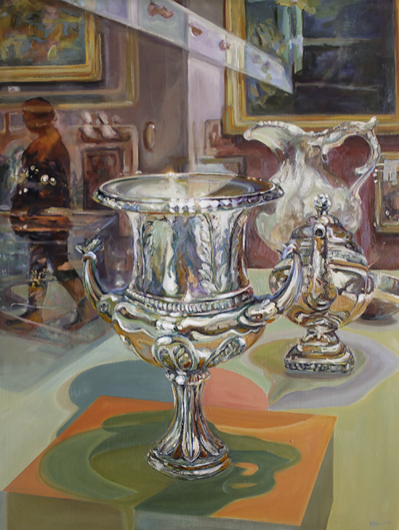
“Cultural appropriation is deeply concerning. I spent a lot of time asking myself, ‘Am I just buying into it? If I’m aestheticizing these images and making them culturally generic, am I doing the same thing all over again?” But, what I’m doing exists in a state of irony. I’m showing it in an extreme form to be able to reveal it for what it is.”
In White Noise at 709, Kovak continues her analysis of museum environments, depicting different objects in large beautiful rooms and inside glass cases, all in a claustrophobic space with numerous details to explore. However, the most captivating thing about the exhibit is the wall drawing. The moment one steps into the space, they notice the grey painted walls, and the pencil marks etched over them. Kovak outlined shadows, created fabricated reflections of light switches, scrawled in bumps on the walls that aren’t there and more.
“I wanted the audience to come in and have the same experience at the gallery that I do when I’m looking at a form that I’m drawing. It’s often a matter of emphasizing what’s already present. I want to reward the viewer for looking. If they search carefully enough, there’s always a little something extra…”
This hunt for detail and constant exploration of perspective that the audience physically interacts with is reflective of our current political climate. She told us that after the election results of last year, she and a fellow artist questioned whether art exploring “visual phenomena” was relevant anymore.
“We realized that entire election cycle was about perception…If you don’t pay attention to nuance, you miss everything. In the nuance and in the grey area is where all of the actual policy happens and all of the actual debate occurs…We need to stay alert and stay cautious as we take in information, because if you look deeper, there’s always more.”
“While the main content of the work is aesthetic, I am political and therefore, my work is also political. It’s an outgrowth of what matters to me…There is something honest about drawing. It eliminates color and it eliminates the bells and whistles. It is a fundamentally raw, direct process. In drawing, the history of how you changed things is always there. It’s about transparency.”
The Opening Reception for On Looking and White Noise is Saturday, December 2nd from 6-8pm and the exhibit, which is free to the public, is open through January 28th.



